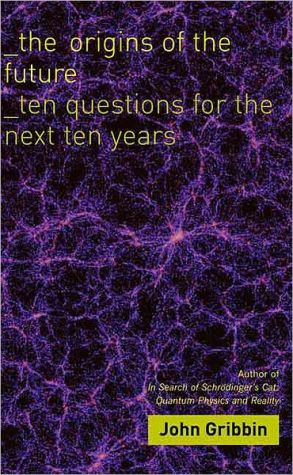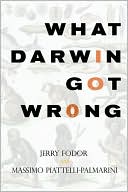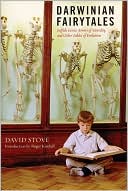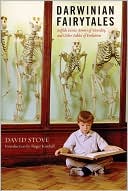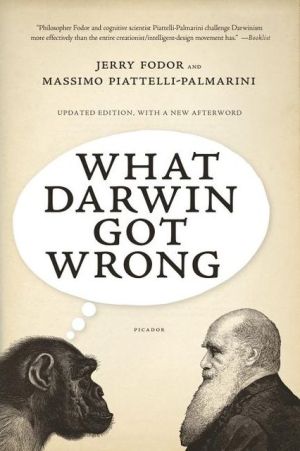The Origins of the Future: Ten Questions for the Next Ten Years
How did the universe begin? Where do galaxies come from? How do stars and planets form? Where do the material particles we are made of come from? How did life begin? Today we have only provisional answers to such questions. But scientific progress will improve these answers dramatically over the next ten years, predicts John Gribbin in this riveting book. He focuses on what we know—or think we know—about ten controversial, unanswered issues in the physical sciences and explains how current...
Search in google:
How did the universe begin? Where do galaxies come from? How do stars and planets form? Where do the material particles we are made of come from? How did life begin? Today we have only provisional answers to such questions. But scientific progress will improve these answers dramatically over the next ten years, predicts John Gribbin in this riveting book. He focuses on what we know—or think we know—about ten controversial, unanswered issues in the physical sciences and explains how current cutting-edge research may yield solutions in the very near future.With his trademark facility for engaging readers with or without a scientific background, the author explores ideas concerning the creation of the universe, the possibility of other forms of life, and the fate of the expanding cosmos. He examines “theories of everything,” including grand unified theories and string theory, and he discusses the Big Bang theory, the origin of structure and patterns of matter in the galaxies, and dark mass and dark energy. In the final chapter of the book, Gribbin ponders the future of Earth and the Sun and the possibility that the universe might expand forever. Library Journal For anyone who's ever wondered about the physics behind the universe at large, Gribbin (visiting fellow, astronomy, Univ. of Sussex; In Search of Schr dinger's Cat: Quantum Physics and Reality) has provided a fairly in-depth look at physicists' current understanding of its beginning (the Big Bang), its evolution to its current state, and its eventual fate. Gribbin makes the distinction between "what we think we know" and "what we think we know" to help the reader understand how physicists have reached the conclusions he's presenting. Aimed at a somewhat educated audience, the text is nonetheless written for the lay reader, i.e., one who has an interest in both particle physics and astrophysics but has not necessarily studied either. His style makes the subject matter more approachable as he explains the links between the two subdisciplines, namely, how astrophysics can provide insight into and confirmation of the theories in particle physics. An accessible read, Origins of the Future will make a fine addition to any general science collection. Recommended. Marcia R. Franklin, MS, MLIS, St. Paul Copyright 2006 Reed Business Information.
The Origins of the Future\ Ten Questions for the Next Ten Years \ \ By John Gribbin \ Yale University Press\ Copyright © 2006 John and Mary Gribbin\ All right reserved.\ ISBN: 978-0-300-11998-5 \ \ \ Chapter One\ How Do We Know the Things We Think We Know? \ What do scientists mean when they say that they "know" what goes on inside an atom, say, or what happened in the first three minutes of the life of the Universe? They mean that they have what they call a model of the atom, or the early Universe, or whatever it is they are interested in, and that this model matches the results of their experiments or their observations of the world. Such a scientific model is not a physical representation of the real thing, the way a model aircraft represents a full-scale aircraft; it is a mental image which is described by a set of mathematical equations. The atoms and molecules that make up the air that we breathe, for example, can be described in terms of a model in which we imagine each particle to be a perfectly elastic little sphere (a tiny billiard ball), with all the little spheres bouncing o one another and the walls of their container.\ That is the mental image, but this is only half the model; what makes it a scientific model is that the way the spheres move and bounce off one another is described by a set of physical laws, written in terms of mathematicalequations. In this case, these are essentially the laws of motion discovered by Isaac Newton more than three hundred years ago. Using those mathematical laws, it is possible to predict, for example, what will happen to the pressure exerted by a gas if it is squashed into half its initial volume. If you do the experiment, the result you get (in this case, the pressure will double) matches the prediction of the model, which makes it a good model.\ Of course, we should not be surprised that the standard model of a gas which describes it in terms of little balls bouncing o one another in accordance with Newton's laws makes this particular correct prediction, because the experiments were done first and the model was designed, or constructed, to match the results of the experiments. The next stage in the scientific process is to use the model you have developed from measurements carried out in one set of experiments to make predictions (precise, mathematical predictions) about what will happen to the same system when you do different experiments. If the model makes the "right" predictions under the new circumstances, this shows that it is a good model. Even if it fails to make the right predictions it may not have to be completely discarded, because it still tells us something useful about the earlier experiments; but at best it has restricted applicability.\ In fact, all scientific models have restricted applicability. None of them is the truth. The model of an atom as a perfectly elastic little sphere works fine for calculating changes in pressure of a gas under different circumstances, but if you want to describe the way an atom emits or absorbs light, you need a model of the atom in which it has at least two components, a tiny central nucleus (which can itself, for some purposes, be regarded as a perfectly elastic little sphere) surrounded by a cloud of electrons. Scientific models are representations of reality, not the reality itself, and no matter how well they work or how accurate their predictions are under the appropriate circumstances, they should always be regarded as approximations and aids to the imagination, rather than as the ultimate truth. When scientists tell you that, say, the nucleus of an atom is made up of particles called protons and neutrons, what they should really say is that the nucleus of an atom behaves, under certain circumstances, as if it were made up of protons and neutrons. The better scientists take the "as if" as read but appreciate that their models are, indeed, only models; lesser scientists often forget this crucial distinction.\ Lesser scientists, and many nonscientists, also have another misconception. They often think that the role of scientists today is to carry out experiments which will prove the accuracy of their models to better and better precision-to more and more decimal places. Not at all! The reason for carrying out experiments which probe previously untested predictions of the models is to find out where the models break down. It is the cherished hope of the best physicists to find flaws in their models, because those flaws-things that the models cannot predict accurately or cannot explain in detail-will highlight the places where we need a new understanding and better models.\ The archetypal example of this is gravity. Isaac Newton's law of gravity was regarded as the most profound piece of physics for more than two hundred years, from the 1680s to the beginning of the twentieth century. But there were a few, seemingly tiny, things that the Newtonian model could not explain (or predict), involving the orbit of the planet Mercury and the way light is bent when it goes past the Sun. Albert Einstein's model of gravity, based on his general theory of relativity, explains everything that Newton's model explains, but it also explains these subtle details of planetary orbits and light bending. In that sense, it is a better model than the older model, Newton's, and it makes correct predictions (in particular, about the Universe at large) that the older model does not. But Newton's model is still all you need if you are calculating the flight of a space probe from the Earth to the Moon. You could do the same calculation using general relativity, but it would be more tedious and it would give you the same answer, so why bother?\ Most of this book will be about things we think we know-models which look good as far as they have been tested, but which involve emerging science, for which many more tests remain to be carried out. It is certain that some of these models will require modification in light of further experiments and observations of the Universe; it is possible that some of them may have to be completely discarded and replaced by new ways of looking at things. But to set the scene for our description of where science is going in the twenty-first century, we need to start from the things we think we know-models, essentially developed in the twentieth century, that have been so successful at matching the results of experiment and observation that scientists have almost as much faith in them as they have in the billiard ball model of gases or (within its known limitations) in Newton's model of gravity. These are models which are, like Newton's model, very nearly perfect in their description of the physical Universe within the specific areas for which they are known to apply; just as important, again as with Newton's model, we know where the limits of the applicability of those models are.\ Physicists like to refer to those highly successful descriptions of the world (or rather, of specific features of the world) as "standard" models. The billiard ball model of gases (which is also known as the kinetic theory, since it deals with particles in motion) is a standard model. But when physicists talk of the standard model, they are referring to one of the great triumphs of twentieth-century science, the model which describes the behavior of particles and forces on subatomic scales. And it began, essentially, in the second decade of the twentieth century, when the Danish physicist Niels Bohr came up with a new model of the atom. I have described the historical development of quantum physics in my book In Search of Schrödinger's Cat (1984) and do not intend to go into details here; but since the standard model of particle physics is entirely based on quantum physics, a brief recap is in order. At first sight, some of this may seem familiar to some readers; but bear with me, because I hope you will find that my take on this familiar story is not quite the same as what you think you know.\ The first step toward this new understanding of physics came from Max Planck in Germany at the beginning of the twentieth century. Planck discovered that the only way observations of the way light is radiated by hot objects could be explained was if the light were emitted in little lumps, packets called quanta. At that time, scientists thought of light as a form of wave, an electromagnetic vibration, because observations of the behavior of light in many experiments matched the predictions of the wave model. At first, neither Planck himself nor his contemporaries thought that light existed in the form of little lumps, only that the properties of matter-that is, of atoms-meant that it could only be emitted (or absorbed) in certain amounts. You could make an analogy with a dripping tap. The fact that water drips from the tap in the form of tiny "lumps" doesn't mean that the water in the tank feeding the tap exists only in the form of separate drops. Albert Einstein, in 1905, was the first person in modern times to take seriously the idea that light actually existed in the form of little lumps, particles of light that came to be known as photons, and for roughly the next ten years he was essentially in a minority of one. But it turns out that the behavior of light in some experiments actually matches the predictions of the particle model. So the particle model must be a good one as well. No experiment shows light behaving like a wave and like a particle at the same time; but light can match the predictions of either model depending on the nature of the experiment.\ It's worth getting this clear, because it is such a fine example of the limitations of models. Nobody should ever have said (or thought) that light is a wave, or is a particle. All we can say is that under appropriate circumstances light behaves as if it were a wave or as if it were a particle-just as under certain circumstances an atom behaves as if it were a little hard ball, while under other circumstances it behaves as if it were a tiny nucleus surrounded by a cloud of electrons. There is no paradox or conflict here. The limitations lie in our models and our human imagination, because we are trying to describe something that is, in its entirety, unlike anything we have experienced with our own senses. The confusion we feel when we are trying to imagine how light can be both a wave and a particle is part of what the American physicist Richard Feynman called "a reflection of an uncontrolled but vain desire to see it in terms of something familiar." Light is actually a quantum phenomenon which can be described very effectively in terms of mathematical equations but for which no single mental image from everyday life will do to give us an idea of what it is like. The whole quantum world is like that, and Niels Bohr's first great contribution to physics was to incorporate the mathematics of quantum physics into a model of the atom without worrying too much about whether that model made sense in everyday terms.\ By the beginning of the twentieth century, scientists knew that everything on Earth is made of atoms and that there is one kind of atom for each of the chemical elements-atoms of oxygen, atoms of gold, atoms of hydrogen, and so on. They also knew that atoms were not indivisible, as had once been thought, but that pieces, called electrons, could be chipped o them under the right circumstances. At that time, the favored model of the electron described it as a tiny particle, and experiments had shown that electrons did, indeed, behave as if they were tiny particles. The puzzle Bohr solved was the way in which light is radiated (or absorbed) by dierent kinds of individual atoms; furthermore, his model explained the puzzle at a more detailed level than had Planck's study of the light emitted by glowing objects made up of many different atoms. If a pure element (such as sodium) is heated in a flame, it radiates at precise wavelengths, or colors, which produce a pattern of lines in the spectrum of visible light, which spans all the colors of the rainbow (indeed, a rainbow is a spectrum). In the case of sodium, the lines are in the orange-yellow part of the rainbow; but each element (which means each kind of atom) produces its own distinctive pattern of lines, as unique as a fingerprint and resembling a barcode. The blend of colors seen in a rainbow is the result of many different kinds of atom all radiating at different wavelengths. This blend usually ends up giving the appearance of white light, but the colors are separated by the way light is bent within raindrops, or, as Isaac Newton's investigations showed, by a triangular prism of glass.\ Now, light is a form of energy, and the energy in light emitted by atoms must come from within the atoms (it is the most basic law of physics that energy cannot be created out of nothing, although even that rule has its limitations, as we shall see). Bohr realized that the energy comes from rearranging the electrons in the outer part of an atom. (Light is, therefore, literally atomic energy, and what has become known, through a quirk of history, as atomic energy should really be called nuclear energy.) Electrons carry negative charge, while the nucleus of an atom carries positive charge, so electrons are attracted to the nucleus in a way similar to the way an object on Earth is attracted by gravity to the Earth itself. If you carry a weight upstairs, you have to do work (put in energy) to move the weight farther away from the center of the Earth. If you drop the weight out of an upstairs window, this energy is released, converted first into the energy of motion of the falling weight and then, when it hits the ground, into heat, warming the ground slightly as it makes the atoms and molecules at the impact site jiggle about. Bohr suggested that in the same sort of way if an electron in the outer part of an atom moved closer to the nucleus, energy would be given up (in this case, as light). If an electron closer to the nucleus absorbed energy (perhaps from light, or because the atom was being heated), it would jump farther out. But why should the energy be emitted and absorbed only at precise wavelengths, corresponding to precise amounts of energy?\ In the model developed by Bohr, an electron is envisaged as moving around the nucleus in a way reminiscent of the way planets orbit around the Sun. But whereas a planet can orbit, in principle, at any distance from the Sun, only certain electron orbits, according to Bohr, were "allowed"-rather as if a planet could occupy the orbit of the Earth or the orbit of Mars, but not anywhere in between. Then, he suggested, an electron could jump from one orbit to another (as if Mars jumped into the Earth's orbit) and emit a precise amount of energy (corresponding to a precise wavelength of light) in the process. But it could not jump to an in-between orbit, and emit an in-between amount of energy because there were no in-between orbits. Of course, he supplied mathematics to back this up, based on studies of spectra, and the physics was developed by further experiments and observations. What matters, however, is that Bohr found a model which could predict where the lines in atomic spectra should be, even though the idea of what became known as "quantized" orbits made no sense in terms of our everyday experience. Equally baffling, according to this model changes occur as if an electron disappears from one orbit and instantly appears in another orbit without ever crossing the space in between. Although it took a long time for scientists to grasp the point, Bohr had made it clear that a model doesn't have to make sense in order to be a good model; all it has to do is make predictions (based on sound mathematics and observed physics) that match the outcome of experiments.\ (Continues...)\ \ \ \ \ Excerpted from The Origins of the Future by John Gribbin Copyright © 2006 by John and Mary Gribbin. Excerpted by permission.\ All rights reserved. No part of this excerpt may be reproduced or reprinted without permission in writing from the publisher.\ Excerpts are provided by Dial-A-Book Inc. solely for the personal use of visitors to this web site. \ \
Preface: Origins ixAcknowledgments xiiiHow Do We Know the Things We Think We Know? 1Is There a Theory of Everything? 28How Did the Universe Begin? 51How Did the Early Universe Develop? 72Why Is the Universe the Way It Is? 98What Is It That Holds the Universe Together? 126Where Did the Chemical Elements Come From? 157Where Did the Solar System Come From? 184Where Did Life Originate? 213How Will It All End? 246Glossary 271Bibliography 277Index 281
\ Library JournalFor anyone who's ever wondered about the physics behind the universe at large, Gribbin (visiting fellow, astronomy, Univ. of Sussex; In Search of Schr dinger's Cat: Quantum Physics and Reality) has provided a fairly in-depth look at physicists' current understanding of its beginning (the Big Bang), its evolution to its current state, and its eventual fate. Gribbin makes the distinction between "what we think we know" and "what we think we know" to help the reader understand how physicists have reached the conclusions he's presenting. Aimed at a somewhat educated audience, the text is nonetheless written for the lay reader, i.e., one who has an interest in both particle physics and astrophysics but has not necessarily studied either. His style makes the subject matter more approachable as he explains the links between the two subdisciplines, namely, how astrophysics can provide insight into and confirmation of the theories in particle physics. An accessible read, Origins of the Future will make a fine addition to any general science collection. Recommended. Marcia R. Franklin, MS, MLIS, St. Paul Copyright 2006 Reed Business Information.\ \
